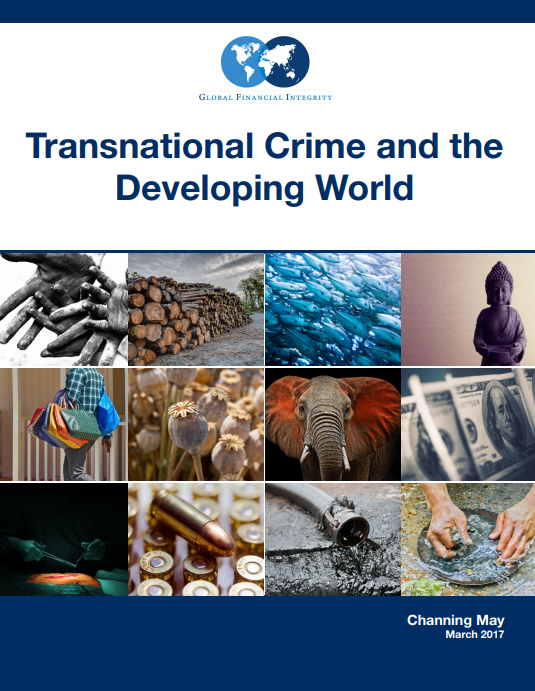By Channing May
The report “Transnational Crime and the Developing World” finds that globally the business of transnational crime is valued at an average of $1.6 trillion to $2.2 trillion annually. The study evaluates the overall size of criminal markets in 11 categories: the trafficking of drugs, arms, humans, human organs, and cultural property; counterfeiting, illegal wildlife crime, illegal fishing, illegal logging, illegal mining, and crude oil theft.
The combination of high profits and low risks for perpetrators of transnational crime and the support of a global shadow financial system perpetuate and drive these abuses. The report also emphasizes how transnational crime undermines economies, societies, and governments in developing countries. National and global policy efforts that focus on curtailing the money are needed to more successfully combat these crimes and the illicit networks perpetrating them.
Primary Findings
Transnational crime is a business, and business is very good. Money is the primary motivation for these illegal activities. Of the 11 illicit activities studied, counterfeiting ($923 billion to $1.13 trillion) and drug trafficking ($426 billion to $652 billion) have the highest and second-highest values, respectively; illegal logging is the most valuable natural resource crime ($52 billion to $157 billion).
The ranges demonstrate the serious magnitude of and threat posed by global transnational crime. The revenues generated from the 11 crimes covered in this report not only line the pockets of the perpetrators but also finance violence, corruption, and other abuses. Very rarely do the revenues from transnational crime have any long-term benefit to citizens, communities, or economies of developing countries. Instead, the crimes undermine local and national economies, destroy the environment, and jeopardize the health and wellbeing of the public.
The report rankings for the illicit markets examined are:
| Transnational Crime |
Estimated Annual Value (US$) |
| Total |
$1.6 trillion to $2.2 trillion |
| Trafficking in Cultural Property |
$1.2 billion to $1.6 billion |
| Small Arms & Light Weapons Trafficking |
$1.7 billion to $3.5 billion |
| Illegal Mining |
$12 billion to $48 billion |
| IUU Fishing |
$15.5 billion to $36.4 billion |
| Human Trafficking |
$150.2 billion |
| Drug Trafficking |
$426 billion to $652 billion |
| Illegal Wildlife Trade |
$5 billion to $23 billion |
| Crude Oil Theft |
$5.2 billion to $11.9 billion |
| Illegal Logging |
$52 billion to $157 billion |
| Organ Trafficking |
$840 million to $1.7 billion |
| Counterfeiting |
$923 billion to $1.13 trillion |
Policy Recommendations
Transnational crime will continue to grow until the paradigm of high profits and low risks is challenged. In addition to current efforts to fight these crimes, this report calls on governments, experts, the private sector, and civil society groups to seek to address the global shadow financial system by promoting greater financial transparency. This will help cutoff the money flows and the profits, and it will increase the ability to bring these criminals to justice and defeat their illicit transnational networks.
GFI recommends several steps governments and other regulatory bodies can take to increase the levels of detection and interdiction of the proceeds of transnational crime:
- Require that corporations registering and doing business within a country declare the name(s) of the entity’s true, ultimate beneficial owner(s)
- Flag financial and trade transactions involving individuals and corporations in “secrecy jurisdictions” as high-risk and require extra documentation
- Scrutinize import and export invoices for signs of misinvoicing, which may indicate technical and/or physical smuggling
- Use world market price databases such as GFTradeTM to estimate the risk of misinvoicing for the declared values and investigate suspicious transactions
- Share more information between agencies and departments on the illicit markets and actors that exist within a country’s borders
Methodology
The basis of the value estimates in this report is a compilation of numerous datasets and price statistics from governments, non-governmental bodies, law enforcement, and other experts. Each illicit market chapter briefly notes the methodology and data sources used for those goods, and a detailed description of certain methodologies, as well as tables with all of the data and sources used, are provided in the Appendix. Most of the estimates the report highlights are ranges rather than a single figure, because there is less precision in data pertaining to activities that are trying to stay hidden, such as transnational crime.

